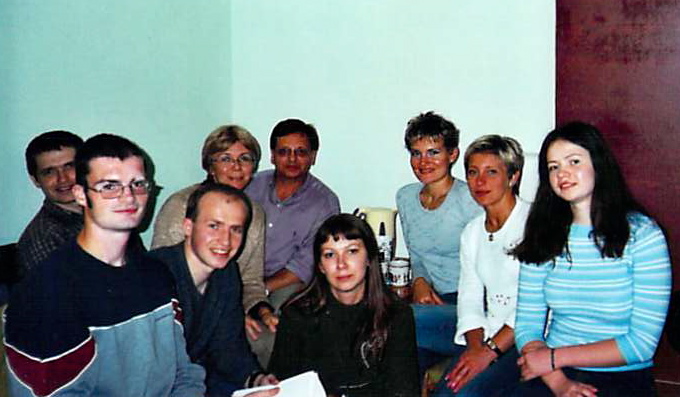| Who am I? My name is Alex (short for Oleksandr/Aleksandr) Shcheglovitov. I am an Assistant Professor in the Department of Neurobiology & Anatomy at the University of Utah. I am from Ukraine. I was born and raised in Shostka, a small city in northeast Ukraine, and went to college and graduate school in Kyiv. I earned my Bachelor’s degree in Applied Physics and Master’s degree in Biophysics from the National Technical University of Ukraine “KPI” and my Ph.D. degree in Biophysics from the Bogomoletz Institute of Physiology of the National Academy of Sciences of Ukraine. |
I completed my thesis work with Yaroslav Shuba in the Department of General Physiology of the Nervous System. Dr. Shuba was one of the first to characterize the single channel properties of T-type calcium channels. In his lab, I learned electrophysiology and studied the biophysical and pharmacological properties of different subtypes of low-voltage–activated T-type calcium channels (Shcheglovitov et al., 2005 and Shcheglovitov et al., 2007).
I did my first postdoctoral training with Ed Perez-Reyes in the Department of Pharmacology in the University of Virginia. Dr. Perez-Reyes was the first to clone T-type calcium channels. In his lab, I investigated the molecular and biophysical mechanisms of the modulation of N-type calcium channels by auxiliary beta subunits (Vitko, Shcheglovitov et al., 2008), R-type calcium channels by trace metals (Shcheglovitov et al., 2012), and T-type calcium channels by both alternative splicing (Shcheglovitov, Vitko et al., 2008) and mutations found in patients with childhood absence epilepsy (Eckle, Shcheglovitov et al., 2014). I spent two incredibly productive and fun years at UVa and learned the intricacies of molecular cloning techniques.
I moved to Stanford for my second postdoc with Ricardo Dolmetsch in the Department of Neurobiology of Stanford University School of Medicine. I was very fascinated by Dr. Dolmetsch’s studies on the calcium regulation of gene expression, and in his lab I originally hoped to investigate whether and how T-type calcium channels influence gene expression. However, at that point, the Dolmetsch lab was beginning to pioneer the use of induced pluripotent stem cells (iPSCs) for disease modeling, and I became deeply involved in the characterization of the functional properties of human iPSC-derived neurons. Initially, I was skeptical about this technique, because the success rate for generating functionally mature neurons was very low. However, things began to take off when I learned how to label functional neurons. It became obvious to me that this approach has huge potential for human disease modeling and regenerative medicine, and I decided to re-specialize and learn as much as possible about human genetics, stem cells, and neurodevelopment. I attended courses at Stanford and participated in the lab meetings of Dr. Renee Reijo-Pera’s group, who kindly agreed to be my co-adviser. I learned how to obtain iPSCs and convert them into functional cortical neurons. I also developed a platform for studying synaptic transmission in iPSC-derived neurons and applied it to investigating the synaptic properties of neurons derived from patients with 22q13 deletion syndrome (Shcheglovitov et al., 2013). Remarkably, we found that neurons derived from these patients have severely impaired excitatory but not inhibitory synaptic transmission, as compared to control neurons, and that this impairment can be restored by increasing the expression level of Shank3 or by treating neurons with insulin growth factor 1 (IGF1). Also, we discovered that Shank3 and IGF1 lead to the formation of different types of excitatory synapses that express different scaffolding proteins and have different functional properties. These observations were the source of my keen interest in understanding the molecular mechanisms underlying the development and function of synapses in human neurons and illuminated the path for my future development as an independent investigator.
Now, I am very excited to start my lab in the Department of Neurobiology and Anatomy at the University of Utah! We will study the development and function of synapses in human neurons and advance of our understanding of the cellular and molecular mechanisms underpinning the development of neurological abnormalities in human neuropsychiatric disorders associated with autism, intellectual disability, schizophrenia, and epilepsy.

